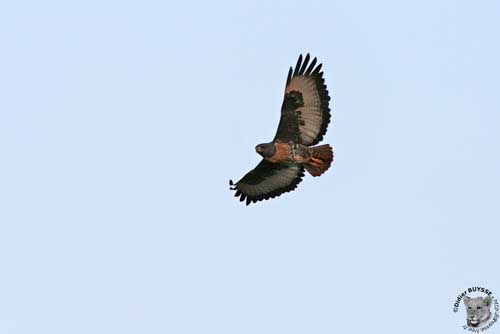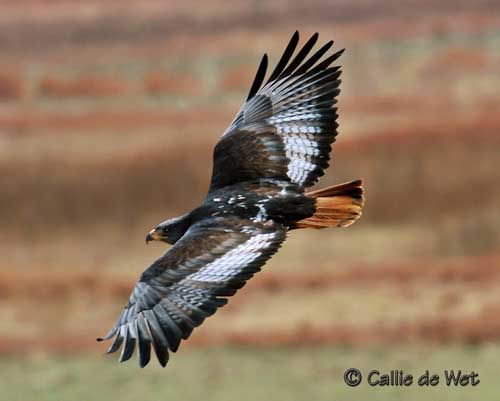
Fr: Buse rounoir
All: Felsenbussard
Esp: Busardo Augur Meridional
Ita: Poiana augurale
Nd: Jakhalsbuizerd
Sd: Schakalvråk
Photographers:
Didier Buysse
Vision d’Oiseaux
Ingo Waschkies
Bird Photography
Callie de Wet
GALLERY
Text by Nicole Bouglouan
Sources:
HANDBOOK OF THE BIRDS OF THE WORLD Vol 2 by Josep del Hoyo-Andrew Elliot-Jordi Sargatal - Lynx Edicions - ISBN: 8487334156
BIRDS OF PREY OF AFRICA AND ITS ISLANDS by Alan and Meg Kemp - Struik Publishers - ISBN: 1770073698
L’ENCYCLOPEDIE MONDIALE DES OISEAUX - Dr Christopher M. Perrins - BORDAS - ISBN: 2040185607
BIRDS OF AFRICA SOUTH OF THE SAHARA by Ian Sinclair and Peter Ryan - Princeton University Press Princeton and Oxford - ISBN: 0691118159
BirdLife International (BirdLife International)
Global Raptor Information Network - Working to Conserve Birds of Prey in nature
Biodiversity Explorer – The Web of Life in Southern Africa
Wikipedia, the free encyclopaedia
Jackal Buzzard
Buteo rufofuscus
Accipitriformes Order – Accipitridae Family
INTRODUCTION :
The Jackal Buzzard is endemic to South Africa. The English name of this bird comes from the loud yelping calls, similar to those of the Black-backed Jackal.
This is a stocky buzzard with long, broad wings, large rounded head and relatively short, but strong legs. Some adults have a white-breasted morph.
DESCRIPTION OF THE BIRD:
Biometrics:
Length: 45-55 cm
Wingspan: 130-132 cm
Weight: 865-1080 g
The adult has black head, neck, throat and upperparts. On the upperwing, the flight feathers are black, narrowly barred pale grey, and show broad, black tips. The tail is rufous.
On the underparts, the breast is usually rufous with white upper edge contrasting against the black throat, and black markings on the lower edge. Lower breast, belly and underwing-coverts are black with narrow greyish-white bars. Flanks, thighs and vent are white or rufous.
The bill is black with yellow cere. The eyes are dark red-brown. Legs and feet are yellow.

The breast is rarely all-white or all-black, but some adult birds may show this particular feature.
The female has similar plumage but she is larger and heavier than the male.
The juvenile is browner. It has dark brown upperparts with pale-edged feathers on nape, back and upperwing-coverts, involving scaly pattern. The underparts are paler, mostly rufous-brown. The tail is brown instead of rufous. The underwing-coverts are pale brown. Cere and legs are dull yellow. The eyes are dark brown.
The immature plumage is visible at 6 months and the adult plumage at three years.
RANGE:
The Jackal Buzzard is present in South Africa, in S and C Namibia, Lesotho, Swaziland, S Mozambique and S Botswana. It is vagrant to S Botswana and Zimbabwe.
HABITAT:
The Jackal Buzzard frequents mainly hilly and mountainous habitats. It occurs from high Drakensberg Mountains to small hills in the Namib Desert, ranging from open steppes and grassland above 1000 metres, but also up to 3000 metres of elevation.
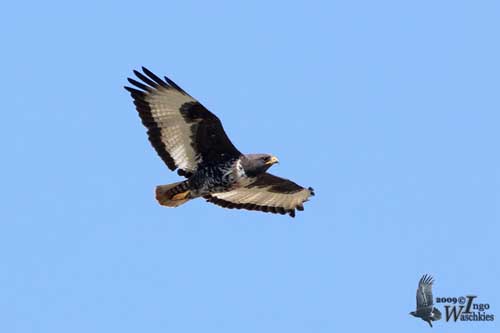
CALLS AND SONGS: SOUNDS BY XENO-CANTO
The Jackal Buzzard gives loud, yelping calls reminiscent of that of jackal, “kyaah-ka-ka-ka”, or barking calls “kweh”, mainly uttered during the flight displays. Another harsh display call is also heard “kow-kow-kow-kow”.
This species is usually vocal all year round.
BEHAVIOUR IN THE WILD:
The Jackal Buzzard feeds on insects, small reptiles, mammals, birds and carrion. It perches on rocks, trees or utility poles in open areas, where it can spend much time while searching for preys.
It also hunts on the wing by soaring or hanging in strong winds. Once a prey is located, it descends to the ground to catch it. It can intercept the birds in the air. During winter, it often scavenges at carcasses and road-kills along the roads.
During the breeding season, the Jackal Buzzard is usually monogamous and territorial solitary nester. However, some occasional examples of polyandry are reported in Lesotho highlands, where one female mates with two males.
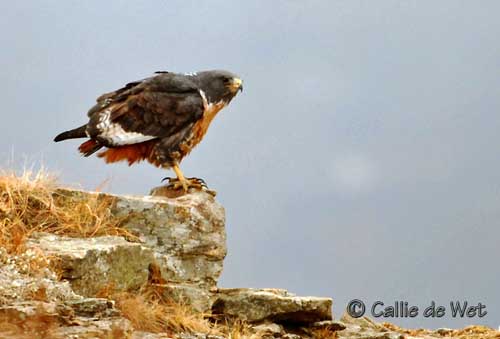
Like numerous raptors, the Jackal Buzzard performs beautiful aerial displays including mutual circling and gentle stoops by male, often accompanied by loud calls.
The same territory and the same nest are often reused for several following years. Like the Augur Buzzard, the pair usually has 2-3 nests about one kilometre apart from each other, also used outside breeding.
The Jackal Buzzard is sedentary in its range, but juveniles and some adults may move to open plains in non-breeding season according to the prey availability.
It flies with deep, strong strokes. It soars with rocking flight or hangs in the strong winds with bent wrists.
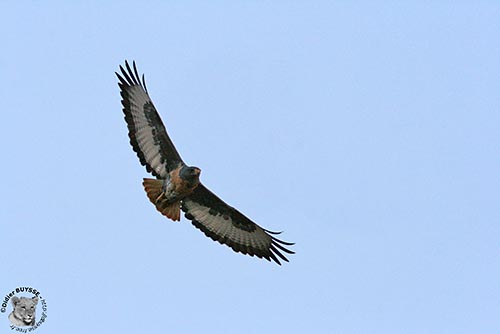
REPRODUCTION OF THIS SPECIES:
The laying occurs between May and November, but the peak varies slightly according to the range.
Both sexes build the nest, a typical structure made with sticks and lined with grass and green leaves. It is usually placed on cliff ledge, at base of bush or tree, up to 30 metres above the ground. However, it may also be built in a large tree fork, between 6 and 15 metres above the ground.
The female lays 1-3 (usually 2) white or bluish-white eggs with brown markings. The incubation lasts 39-40 days, mainly by female. The male feeds her at nest during this period.
At hatching, the chicks are covered in white down. The younger sibling is often killed by the elder chick. The young is fed by the female with preys brought at nest by the male. It fledges 50-53 days after hatching, and still depends on parents for food for some weeks more.
PROTECTION / THREATS / STATUS:
The Jackal Buzzard is common on roads through small farming areas of Karoo steppe and short Highveld grasslands, and in mountainous Transvaal habitats in South Africa. But it is probably less common in lowland areas.
The population appears stable, and the Jackal Buzzard is not currently threatened.
